(完整版)手机结构设计检查表-checklist-重要
- 格式:doc
- 大小:90.01 KB
- 文档页数:7
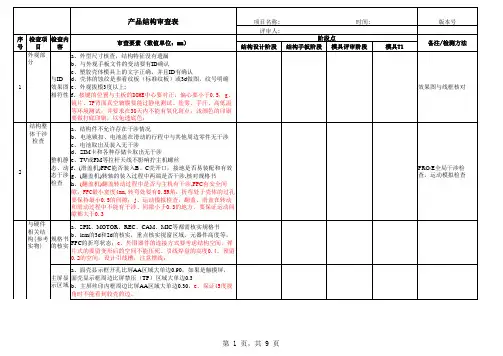
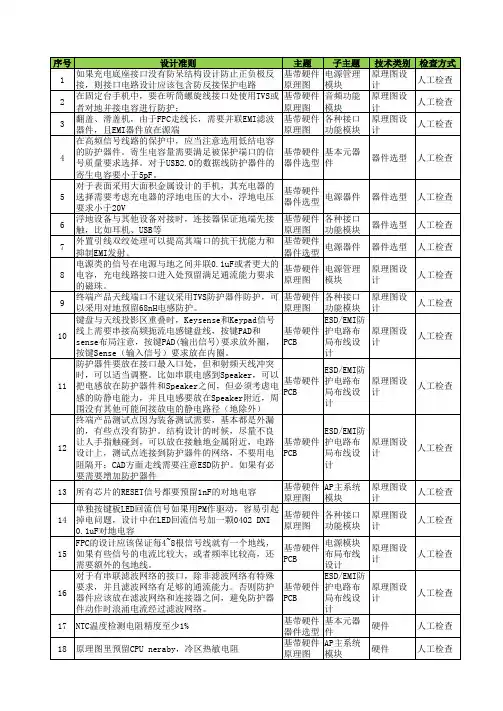
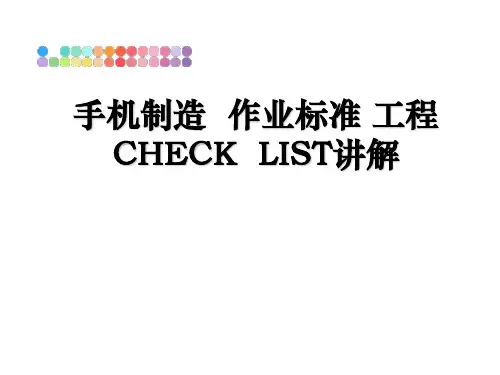
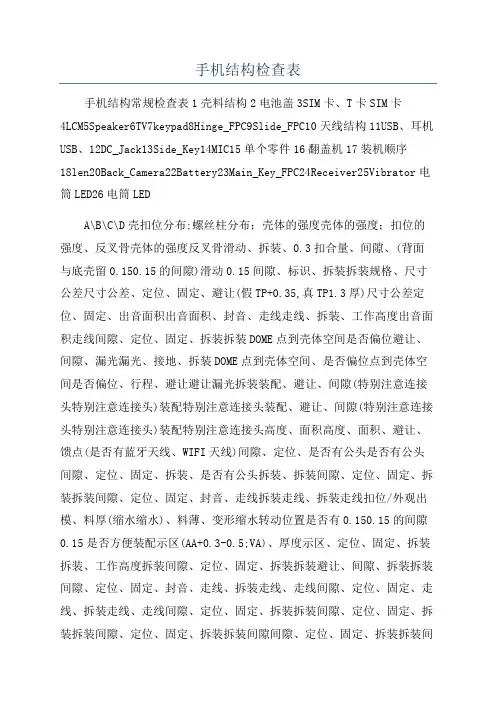
手机结构检查表手机结构常规检查表1壳料结构2电池盖3SIM卡、T卡SIM卡4LCM5Speaker6TV7keypad8Hinge_FPC9Slide_FPC10天线结构11USB、耳机USB、12DC_Jack13Side_Key14MIC15单个零件16翻盖机17装机顺序18len20Back_Camera22Battery23Main_Key_FPC24Receiver25Vibrator电筒LED26电筒LEDA\B\C\D壳扣位分布;螺丝柱分布;壳体的强度壳体的强度;扣位的强度、反叉骨壳体的强度反叉骨滑动、拆装、0.3扣合量、间隙、(背面与底壳留0.150.15的间隙)滑动0.15间隙、标识、拆装拆装规格、尺寸公差尺寸公差、定位、固定、避让(假TP+0.35,真TP1.3厚)尺寸公差定位、固定、出音面积出音面积、封音、走线走线、拆装、工作高度出音面积走线间隙、定位、固定、拆装拆装DOME点到壳体空间是否偏位避让、间隙、漏光漏光、接地、拆装DOME点到壳体空间、是否偏位点到壳体空间是否偏位、行程、避让避让漏光拆装装配、避让、间隙(特别注意连接头特别注意连接头)装配特别注意连接头装配、避让、间隙(特别注意连接头特别注意连接头)装配特别注意连接头高度、面积高度、面积、避让、馈点(是否有蓝牙天线、WIFI天线)间隙、定位、是否有公头是否有公头间隙、定位、固定、拆装、是否有公头拆装、拆装间隙、定位、固定、拆装拆装间隙、定位、固定、封音、走线拆装走线、拆装走线扣位/外观出模、料厚(缩水缩水)、料薄、变形缩水转动位置是否有0.150.15的间隙0.15是否方便装配示区(AA+0.3-0.5;VA)、厚度示区、定位、固定、拆装拆装、工作高度拆装间隙、定位、固定、拆装拆装避让、间隙、拆装拆装间隙、定位、固定、封音、走线、拆装走线、走线间隙、定位、固定、走线、拆装走线、走线间隙、定位、固定、拆装拆装间隙、定位、固定、拆装拆装间隙、定位、固定、拆装拆装间隙间隙、定位、固定、拆装拆装间隙、定位、固定、拆装拆装间隙、定位、固定(机板扣机板扣)、支撑、拆装机板扣拆装(铝片、锌合金、钢片)接地、厚度、加工形状接地、接地螺丝、螺母的大小、长度、热熔沉台大小、位置、强度厚度、宽度、避让间隙、面积宽度、避让间隙宽度全局多遍多遍检查(干涉位置抓图片)多遍19Front_Camera示区、定位、固定、拆装拆装、工作高度拆装21Cam_flah_light示区、定位、固定、拆装拆装27跑马灯28Hingelide(滑轨)29lide(滑轨)30Pen31PCB32五金33螺丝柱35吊绳孔36辅料37干涉34软胶、装饰件间隙、定位、固定、防呆软胶、注意黑粗体或加红色为重要检查内容,其他细节内容参考设计规范!。
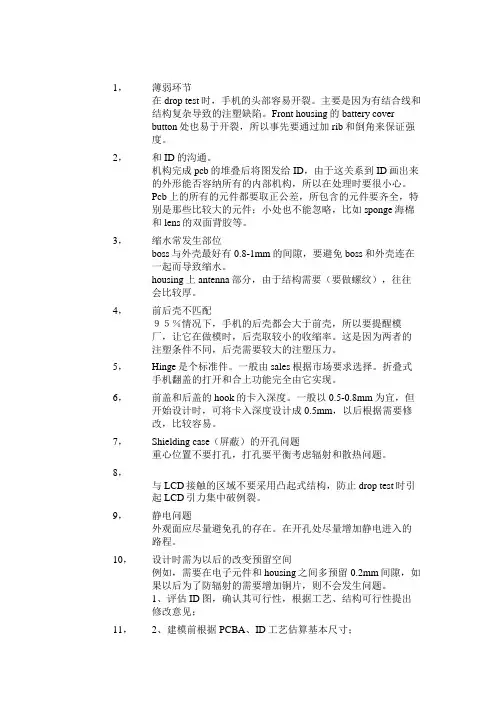
1,薄弱环节在drop test时,手机的头部容易开裂。
主要是因为有结合线和结构复杂导致的注塑缺陷。
Front housing的battery coverbutton处也易于开裂,所以事先要通过加rib和倒角来保证强度。
2,和ID的沟通。
机构完成pcb的堆叠后将图发给ID,由于这关系到ID画出来的外形能否容纳所有的内部机构,所以在处理时要很小心。
Pcb上的所有的元件都要取正公差,所包含的元件要齐全,特别是那些比较大的元件;小处也不能忽略,比如sponge海棉和lens的双面背胶等。
3,缩水常发生部位boss与外壳最好有0.8-1mm的间隙,要避免boss和外壳连在一起而导致缩水。
housing 上antenna部分,由于结构需要(要做螺纹),往往会比较厚。
4,前后壳不匹配95%情况下,手机的后壳都会大于前壳,所以要提醒模厂,让它在做模时,后壳取较小的收缩率。
这是因为两者的注塑条件不同,后壳需要较大的注塑压力。
5,Hinge是个标准件。
一般由sales根据市场要求选择。
折叠式手机翻盖的打开和合上功能完全由它实现。
6,前盖和后盖的hook的卡入深度。
一般以0.5-0.8mm为宜,但开始设计时,可将卡入深度设计成0.5mm,以后根据需要修改,比较容易。
7,Shielding case(屏蔽)的开孔问题重心位置不要打孔,打孔要平衡考虑辐射和散热问题。
8,与LCD接触的区域不要采用凸起式结构,防止drop test时引起LCD引力集中破例裂。
9,静电问题外观面应尽量避免孔的存在。
在开孔处尽量增加静电进入的路程。
10,设计时需为以后的改变预留空间例如,需要在电子元件和housing之间多预留0.2mm间隙,如果以后为了防辐射的需要增加铜片,则不会发生问题。
1、评估ID图,确认其可行性,根据工艺、结构可行性提出修改意见;11,2、建模前根据PCBA、ID工艺估算基本尺寸;12,3、根据ID提供的线框构建线面。
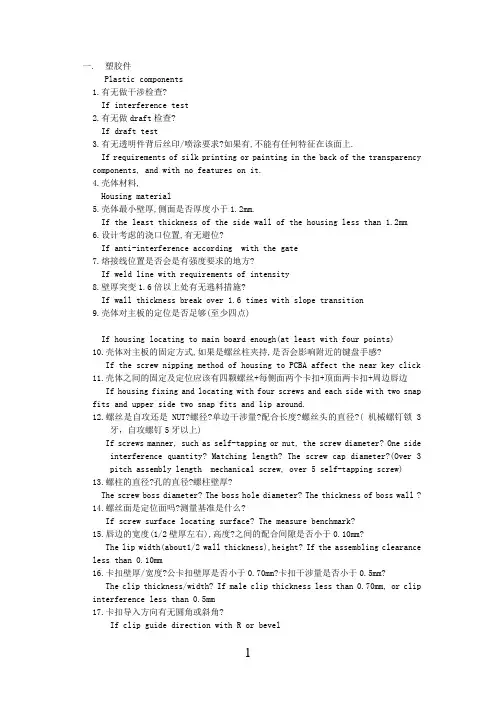
一. 塑胶件Plastic components1.有无做干涉检查?If interference test2.有无做draft检查?If draft test3.有无透明件背后丝印/喷涂要求?如果有,不能有任何特征在该面上.If requirements of silk printing or painting in the back of the transparency components, and with no features on it.4.壳体材料,Housing material5.壳体最小壁厚,侧面是否厚度小于1.2mm.If the least thickness of the side wall of the housing less than 1.2mm6.设计考虑的浇口位置,有无避位?If anti-interference according with the gate7.熔接线位置是否会是有强度要求的地方?If weld line with requirements of intensity8.壁厚突变1.6倍以上处有无逃料措施?If wall thickness break over 1.6 times with slope transition9.壳体对主板的定位是否足够(至少四点)If housing locating to main board enough(at least with four points)10.壳体对主板的固定方式,如果是螺丝柱夹持,是否会影响附近的键盘手感?If the screw nipping method of housing to PCBA affect the near key click11.壳体之间的固定及定位应该有四颗螺丝+每侧面两个卡扣+顶面两卡扣+周边唇边If housing fixing and locating with four screws and each side with two snap fits and upper side two snap fits and lip around.12.螺丝是自攻还是NUT?螺径?单边干涉量?配合长度?螺丝头的直径?( 机械螺钉锁3牙,自攻螺钉5牙以上)If screws manner, such as self-tapping or nut, the screw diameter? One side interference quantity? Matching length? The screw cap diameter?(Over 3 pitch assembly length mechanical screw, over 5 self-tapping screw)13.螺柱的直径?孔的直径?螺柱壁厚?The screw boss diameter? The boss hole diameter? The thickness of boss wall ?14.螺丝面是定位面吗?测量基准是什么?If screw surface locating surface? The measure benchmark?15.唇边的宽度(1/2壁厚左右),高度?之间的配合间隙是否小于0.10mm?The lip width(about1/2 wall thickness),height? If the assembling clearance less than 0.10mm16.卡扣壁厚/宽度?公卡扣壁厚是否小于0.70mm?卡扣干涉量是否小于0.5mm?The clip thickness/width? If male clip thickness less than 0.70mm, or clip interference less than 0.5mm17.卡扣导入方向有无圆角或斜角?If clip guide direction with R or bevel18.卡扣斜销行位不得少于5mm.在此范围内有无其他影响行位运动的特征?The clip slide pin not less than 5mm,within which if affect slide move 19.LCD周围有无定位/固定的特征rib?If locating or fixing features around LCD20.SPEAKER/RECEIVER/VIBRATOR周边有无定位/固定特征?If locating or fixing features around SPEAKER/RECEIVER/VIBRATOR?21.LENS周边有无对LEN浇口/定位柱/定位脚等的避位?If anti-interference to gate/locating pole/locating foot around LENS 22.对电铸件斜边有无避位?If anti-interference to the electroform components bevel edge23.键盘周边有无定位柱?加强RIB?If locating pole or reinforced rib24.转轴处壁厚是否小于1.2mm?If thickness at the hinge less than 1.2mm?25.转轴处根部有无圆角?多少?If root at the hinge with R? and what is the R?26.唇边与卡扣的配合是否是反卡结构?是否还有空间增加反卡?If the match between lip and clip counter-clip structure? If more space to add counter-clip?27.外置天线处是否有防掰出反卡?If outside antenna with anti-breaking off counter-clip28.电池仓面是否设计了入网标签及其他标签的位置?深度?If battery store surface with PTC label or other label, and what is depth?29.外面拔模角度是否小于2度?If pulling angle less than 2 degree30.热熔柱直径大于0.8mm时是否考虑了防缩水的结构?(空心柱)If protection to avoid shrinkage under melting pole diameter over 0.8mm(hollow pole)?31.超声波焊接材料的匹配性是否与供应商沟通过?If discuss with the supplier about the assembling quality of the ultrasonic weld material32.超声波能量带的设计是否合理(三角形,0.4*0.4)?有无防溢胶设计?If ultrasonic energy belt design (triangle, 0.4*0.4) reasonable? If with anti-spilling glue design?33.螺柱/卡扣处是否会缩水?If shrinkage at the screw boss and the snap34.有无厚度小于0.5mm的大面(大于400平方mm)?If big side(over 400 square mm) with thickness less than 0.5mm35.筋条厚度与壁厚的比例是否小于0.75:1?If the scale of thickness of the rib and the wall less than 0.75:136.铁料是否厚度/直径小于0.40mm?模具是否有尖角?If metal thickness/diameter less than 0.40mm. If mould with sharp angle?37.壳体喷涂区域的考虑,外棱边是否有圆角(大于1mm)以防掉漆?遮蔽夹具的精度?If outside edge with R(over 1mm) to avoid paint falling about the housingspray area, the precision of the shielding jig?38.双色喷涂的工艺缝尺寸是否满足W0.7mm*H0.5mm?If the size of the double color spraying technique slot match the 0.7mm*0.5mm39.塑料材料的颜色色板是否得到?If the plastic color panel available40.喷涂材料与塑材是否匹配?有无油漆厂的确认?颜色色板是否拿到?If spray material match the plastic, if the conformation of the paint plant,if the color panel available41.喷涂/丝印的测试标准及要求是否已经发给供应商?If the spray /silk print test standard and requirement sent to suppliers42. 吊绳孔:方便吊绳,强度可靠,应承受10公斤的拉力If the hang up line hole convenient for hang up line, intensity reliableenough to endure pulling force of 10 kg四, 电池 Batteries外置式电池 Outside battery1.电芯类型?Li-ion/Li-ion Polymer? 最大出厂厚度?Battery core types? Li-ion/Li-ion Polymer? Thickness?2.底壳底面厚度?侧面厚度?材料?What is the housing rear underside thickness? The side face thickness? Materials?3.面壳厚度?材料?What is the cover housing thickness? The materials?4.超声能量带的设计?溢胶措施有无?If ultrasonic energy belt and spilling plastic measures or not5.保护电路空间是否和封装厂确认?If conformation with encapsulation plants about the protection of circuit space6.电池呼吸空间是否考虑?(要留0.20mm的厚度空间)If battery breathing space or not? (0.20mm thickness space)7.内部是否预留粘胶空间(不小于0.15mm供两层双面胶)If double adhesive tape space inside or not (not less than 0.15mm for two layerdouble adhesive tape)8.底壳外表面是否留出标签的地方及厚度?If housing rear exterior side with label place, and the thickness?9.推开电池按钮时,电池能否自动弹出来?If battery flip out automatically when pushing out the battery button10.电池外壳周边是否因为分形线的位置而很锋利?(从截面看)If the battery cover is sharp due to the location of part line11.电池接触片要低于壳体0.3mm,目前设计是多少?The battery touching piece should be 0.3mm lower under the housing, What is the present design?12.电池安装方向是否合适?是否和电池连接器SPEC一致?If battery installation direction correct and in line with battery connector?13.电池按钮材料?能否耐2000次测试?The material of battery button? If battery button submitted to 2000 times test14.按钮如果依靠弹簧或弹片传力,有无借用零件?有无设计参考?要考虑手感.If with the help of components when passing force on spring or metal sheet, If design reference or not , take click into consideration.内置式电池BatteryIn-built batttery1.电芯类型?Li-ion/Li-ion Polymer?最大出厂厚度?Battery core types? Li-ion/Li-ion Polymer? The thickness?2.Li-ion Ploymer封装是否有底壳?厚度?If Li-ion Polymer encapsulation with bottom shell, and the thickness?3.壳体材料?侧边厚度?The housing material? Side face thickness?4.包装纸厚度?标签位置?The package paper thickness? The label location?5.电池接触片要低于壳体0.3mm(NEC标准),目前设计是多少?The battery touching piece should be 0.3mm lower under the housing, What is the present design?6.封装与电池盖的距离是否小于0.10mm?If the distance between battery and battery cover less than 0.10mm7.有无考虑呼吸空间?If breathing space or not ?8.定位及固定方式?The locating and fixing method ?9.安装方向?拆装空间?The installation direction and the disassembling space?10.接触电部位有无固定电池的特征?If battery fixing features at the electricity touching part?11.电池盖固定方式?The battery cover fixing method?12.电池盖材料?厚度?The battery cover material and the thickness?13.电池盖装配方向?拆装方式?卡扣数量?位置?The battery cover installation direction and disassembling method and the quantity of the clips and the location?14.电池盖有无按钮?If button with battery cover15.按钮行程是否正确?顶面是否有圆角以利电池盖滑出?If button travel correct? And if R with the top side as to battery cover sliding out easily?16.按钮材料?能否耐2000次测试?The button material? If pass 2000 times tests17.按钮如果依靠弹簧或弹片传力,有无借用零件?有无设计参考?要考虑手感If with the help of components when passing force on spring or metal sheet,If design reference or not , take click into consideration.五. 小镜片 Sub Lens1.镜片的工艺(IMD/IML/模切/注塑+硬化)The lens techniques (IMD/IML/die cutting/injection+hard coating)2.镜片的材料(PC/PMMA/GLASS)The lens materials(PC/PMMA/GLASS)3.镜片的厚度及最小厚度The lens thickness and the least thickness?4.IMD/IML/注塑镜片P/L,draft,radius?IMD/IML/injection lens P/L,draft, radius?5.固定方式及定位方式,最小粘接宽度是否大于1.5mm?The fixing and the locating methods ? and if the least adhesive width over1.5mm?6.窗口(VA&AA)位置是否正确If window(VA&AA) location correct7.冲击试验是否会有问题(100g钢球20cm高)If impact test ok(100g steel ball 20cm high)8.表面硬度是否足够(2H/3H…)If surface hardness enough(2H/3H…)9.镜片的耐摩擦测试(500g力50次,划伤宽度不大于100微米)The lens friction endurance test(50 times under force of 500g, scratchingmark width less than 100um)10.镜片本身及固定区域有无导致ESD问题的孔洞存在If ESD problems caused by holes in lens and fixed area?11.周边的电铸或金属件如何避免ESDHow to avoid ESD in electroform and metal parts?12.小镜片周边的金属是否会对天线有影响(开盖时)If metal near small lens affect the antenna(when cover lifting)13.镜片外面是否超出壳体面,应该降低0.05mm避免磨损.If lens outside parts beyond housing surface, and should be o.oo5mm loweras to avoid friction14.有无将测试标准发给供应商?If test standard sent to suppliers?六. 转轴Hinge1.转轴的直径The hinge diameter?2.转轴的扭力The hinge torque3.打开角度(SPEC)The opening angle4.有无预压角度(开盖预压为4-7度,建议5度;合盖预压为20度左右)If prepress angle(opening angle 4-7degreee, 5degree suggested; closingangle about 20degree)5.固定有无问题,有无轴向串动?If location ok, and axial move with hinge direction6.装拆有无空间问题?If space ok when (dis)assembling7.固定转轴的壁厚是多少,材料(推荐PC GE C1200HF或者三星HF1023IM)What is the fixed hinge wall thickness and material(PC GE C1200HF or Samsung 10231IM recommended)8.转轴配合处的尺寸及公差是否按照转轴SPEC?If the size and tolerance of the hinge assembling according to hinge SPEC 9.转轴与另一端的支撑是否同心?If the hinge and the crutch on the other end concentric?10.转轴处壳体是否有壁厚不均潜在缩水的可能性?If the hinge housing parts thickness unequal or shrinkage?11.与转轴对应的一端轴套与壳体的配合尺寸;The assembling size of housing and hinge cover opposite the hinge?12.壳体上有无设计转轴终了位置的止动缓冲垫?If stop cushion in the housing at the final state of hinge moving 七. 连接FLIP(SLIDE)/BASE的FPCThe FPC connecting the flip(slide) /base1 .FPC的材料,层数,总厚度The FPC material, layers and total thickness?2.PIN数,PIN宽PIN距PIN quantity, PIN width, and PIN distance3.最外面的线到FPC边的距离是多少(推荐0.3mm)The distance between most outside line and FPC edge ?(0.3mm suggested) 4.FPC内拐角处最小圆角要求大于1mm,且内拐角有0.20mm宽的布铜,防止折裂. The least corner R inside FPC should be over 1mm, and with copper of 0.20mm wide to avoid break5.有无屏蔽层和接地或者是刷银浆?If shielding cover, grounding or silver brushing?6.FPC与壳体的长度是否合适,有无MOCKUP 验证If the length of FPC and housing accurate, and with MOCKUP validation 7.壳体在FPC通过的地方是否有圆角?多少?推荐大于0.20mm.If R in the housing where FPC passes, and the degree ? over 0.20mm suggested 8.FPC与壳体间隙最小值?(推荐值为0.5mm)The least thickness between FPC and housing(0.5mm suggested)?9.FPC不在转轴内的部分是否有定位及固定措施?If location and fixing method in the FPC parts outside the hinge? 10.对应的连接器的固定方式The opposite connector fixing method11.FPC和连接器的焊接有无定位要求?定位孔?If locating requirement at the joint of FPC and the connector ? and the locating hole?12.补强板材料,厚度The strength added board material and the thickness?十四, 装配检查,assembling checkup1.翻盖打开角度The flip angle2.翻盖面和主机面的间隙The clearance between the flip surface and the housing surface 3.各配合零件的配合面处有无拔模If draft at the assembling surface of the assembling components 4.各配合零件之间的间隙是否合理.If the clearance of the assembling components reasonable5.所有零件的干涉检查,The interference test of all the components。
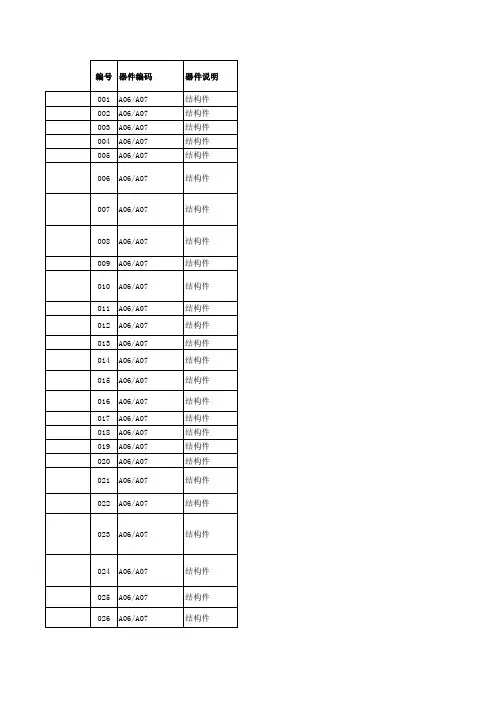
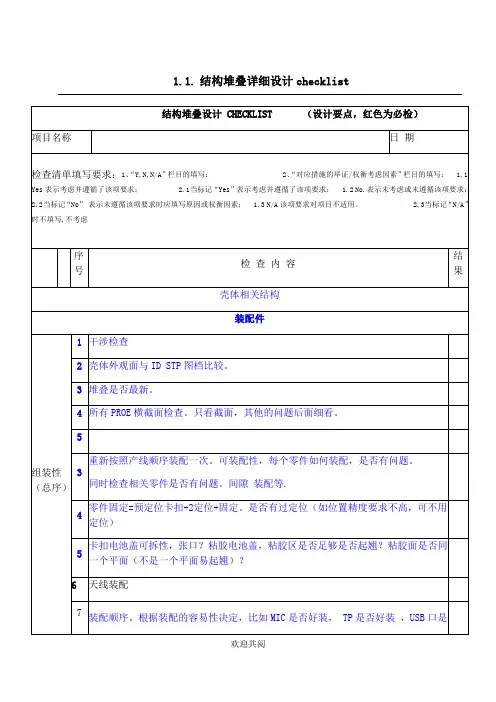
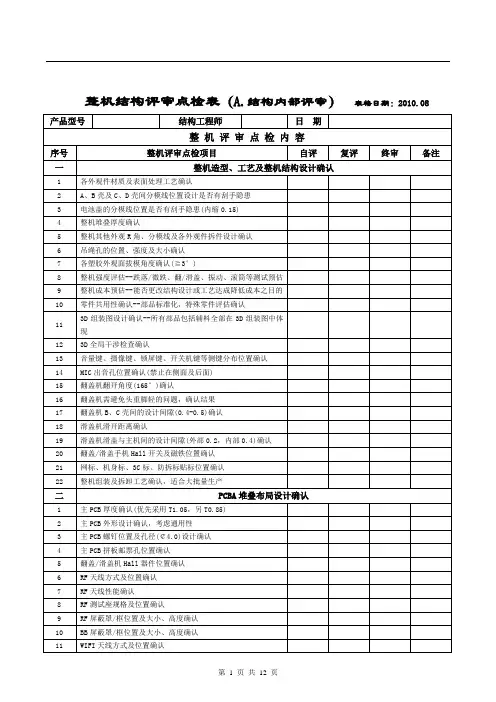
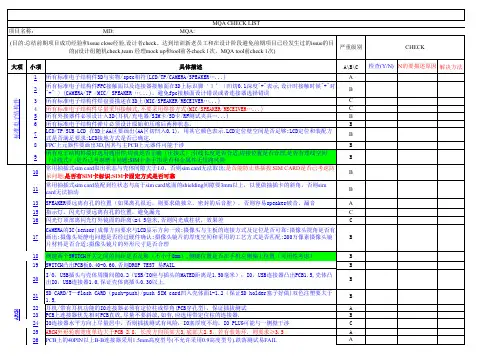
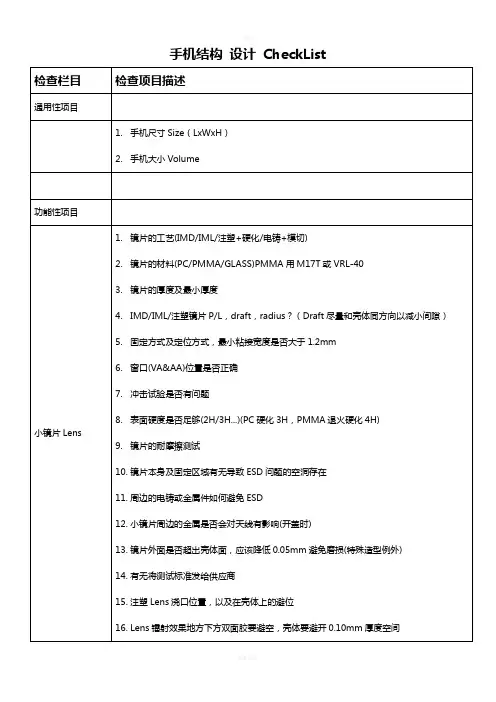
模具的checklist表:产品名称模具编号材料收缩率序号内容自检确认1 与客户交流清楚外观面位置及外观要求如镜面,皮纹,亚光等。
2 清楚产品的安装方向,产品的出模方向及它们之间的关系。
3 产品在出模方向无不合理结构。
4 壁厚合理,壁厚均匀,没有过薄,过厚及壁厚突变。
5 圆角齐全,所有外观面倒圆角(特殊要求除外),所有非外观面倒圆角,非外观面圆角足够大。
且圆角处壁厚均匀,无漏掉的圆角。
6 脱模斜度齐全,正确,无放反的情况,脱模斜度足够大,已用DRAFT CHECK命令进行检查。
7 透明件,皮纹处理的外观面,插穿面脱模斜度足够大,满足标准。
8 透明件已考虑外观效果,可见结构,并与客户进行交流。
9 需贴膜的件已经考虑到膜在实际安装方向的定位,10 电镀件装配考虑到镀层厚度和装配间隙,11 一面用插接,一面用卡爪的结构已考虑到装配过程中是否有与外观干涉,是否有造成外观面破坏的情况,卡爪是否易断12 加强筋高度,宽度,脱模斜度结构及工艺均合理。
13 外观件检查产品结构如壁厚,加强筋(尤其是横在制品侧壁的筋考虑与侧壁的防缩)、螺钉柱等不会引起缩水,已采取防缩措施。
14 产品变形,收缩等注塑缺陷轻微,且已与客户协商,得到客户的书面认可。
15 需出斜顶,滑块,抽芯的结构活动距离及空间足够,结构能否简化。
16 产品无引起模具壁薄,尖角等不合理结构。
17 带嵌件的产品考虑嵌件在模具中的牢固固定,内桶底的嵌件要求将嵌件和包嵌件的胶位合并到一起作为模具嵌件。
18 与客户交流清楚分型面的位置,外观面滑块,抽芯允许的夹线位置。
19 备份产品已检查所有修模报告及更改记录并进行了更改,重要装配尺寸进行了样件的实际测绘验证。
笔记本的CHECKLISTDesign Check List By Sub-Assy.1. U-Case1-1 上下蓋嵌合部份1-1-1 上下蓋PL是否Match1-1-2 Lip 是否完成,是否符合外觀要求(修飾溝)1-1-3 側壁之TAPER / 與下蓋是否配合 / 考慮到開模1-1-4 上下蓋之配合卡勾共幾處,是否位置 match1-1-5 卡勾嵌合深度多少1-1-6 卡勾兩側有無夾持Rib,拆拔時是否易斷裂1-1-7 卡勾是否造成側壁縮水(如果太厚)1-1-8 公模內面形狀(如各處高度).1-1-10 PL切口處是否有刀口產生 ( 全週 Check )1-2 BOSS1-2-1 上下蓋 BOSS 孔位是否相合1-2-2 BOSS 尺寸是否標準化,內緣有沒有倒角1-2-3 BOSS 根部肉厚,是否造成母模縮水1-2-4 BOSS Z軸高度是否正確1-2-5 BOSS 是否足以支持上下蓋結合強度1-2-6 若要電鍍 / 噴導電漆,BOSS前緣要做R角1-2-7 是否有Rib支撐薄弱處.1-3 K/B 配合1-3-1 K/B配合尺寸正確,兩測Rib是否有足夠干涉取卡住.1-3-2 K/B與上蓋週圍GAP較K/B之上限值,每邊再大0.1以上1-3-3 K/B之拆拔方式,cable是否容易插入,角度與深度如何.1-3-4 K/B下方是否有支撐,有無某處特別軟造成浮動.1-3-5 K/B各角落的夾持力為何,是不是易因變形翹起,是否高與鍵盤兩側,是否麼擦到LCD.1-3-6 按各鍵依typing之標準位置,手指是不是會被上蓋磨到1-3-7 K/B是否用做EMI Shielding,若是,與上蓋有多少部份作EMI CONTACT OVERLAPING1-3-8 上述OVERLAPING是否接觸良好,有無需要加貼GASKET,若需要,OVERLAPING需預留高度GAPLCD monitor 結機設計check listCheck Item No. Item & Description1 線材 1. 各線材固定能否確實,是否會造成組裝上的擠壓.2. 附件和配屬的線材固定是否確實,恰當.3. 各貼布使用是否恰當,有無浪費或浮用之餘.4. 線材是否有交錯糾纏之狀況.5. 線材是否有過長的狀況.6. 線材是否有裸露狀況.7. 有cord 線材是否固定確實,有無懸空狀況產生.8. Inverter 線材是否有過長現象,若有過長須注意理線固定方式,不可直接塞入鐵具內.9. AC Line 牽拉是否過長,疑有信號干擾及損線(割傷)狀況.11.AC 線材是否有懸空狀況.12. 線扣是否有固定、或鬆脫狀況.13. Inverter 排線彎曲超過 90 度,恐有折斷之疑慮.2 Connector 1. Connectors Housing 是否固定確實,插拔有無晃動情況.2. Connections Housing 座是否均適當位置,有無造成插拔及各項作業之困難.3. Connectors 座有無因機構設計,導致作業之不便.4. 各接頭孔位是否對正.6. 按鍵是否卡鍵.7. Connector 是否為同一廠商? 如非同一maker會有信賴性風險.8. Panel Connector 端與 LVDS 是否為同一廠商? 如非同一maker會有信賴性風險.3 Power / Inverter Board 1. Power / Inverter Board 固定是否確實、位置是否恰當、有無搖晃狀況,恐造成螺絲鬆脫且產生異音.2. 接地線位置是否有明確標示.3. Power / Inverter Board 與基板距離鎖附孔之距離是否符合安規 ( 安規規定距離5mm ).4.AC 線材是否與其他接線重疊.5. 加隔離罩後是否通風流暢?6 .AC Inlet 未固定於 Main Shielding 上面, 插拔次數過多會造成不良之應力.1.有無螺絲鬆脫狀況2.鎖附螺絲超過PCBA 範圍3.機枱前後搖晃狀況是否符合安規要求4.機檯設計左右是否對稱,不對稱原因為何,是否為原始設計或客戶要求5. Shield 、鐵具部份建議切R角6. 邊飾板是否修銳角,有無刮人狀況產生7. 結構鎖附是否密合,有無斷差產生8. 基座底部加裝墊片,是否平整,前後左右是否均呈水平狀態9.各固定插梢、線材固定樁是否大小尺寸適合,固定確實10. 各螺絲鎖附是否確實,有無設計失當或異常11 .底座是否有無警告標語,控制上下易夾手12. 機殼開孔進風口與出風口面積是否呈對稱性13. 機構開孔是否被 EMI 對策或其他零件阻檔造成空氣流通不良14. Speaker 有無固定,易造成共振15. 前框與後殼間 Gap 是否過大16. 螺絲孔未鎖附螺絲5 PCBA 1. 各項原件是否確實焊接,有無假焊或接反狀況2. PCBA 鎖孔周圍有無 SMD. 0603. 0402 原件插附3. 鎖孔位置是否為點狀吃鍚,非全部吃錫4. 散熱導片之零件是否確實固定於散熱片或鐵具上5. 散熱膏塗佈是否均勻及足夠厚度6. 散熱導片之零件是否確實加塗散熱膏於散熱片或鐵具之間7. PCBA,各零件插件高度是否適宜,有無過高之情形8. PCBA,各零件插件是否平整有無偏斜之情形9. PCBA 板邊到 Components 的距離是否有不足現象> 0.3mm.10. PCBA 板邊有無銅箔翹起之情形11. PCBA 上各零件是否確實平貼於 PCBA、散熱片或鐵具上,兩者之間不可有空隙,恐因鎖附、固定時拉扯,造成損壞12. PCBA,板彎規格 2mm可容許6 標示 1. 按鍵 Function 標示是否明確2. 後 Function 標示板標示方式是否明確3. 警告標示是否標示在正確位置7 包材 1. 包材是否造成塑膠套破損2.包裝袋是否有回收使用標誌/語3 .紙箱是否有把手? 強度是否足夠4. 包裝袋是否打洞8 其他 1. 撫摸檢查機台各處是否有刮手或任何不適之感覺2. 點膠固定是否恰當3. 各部位上加裝之墊片是否確實評估有無脆化或破損之可能性4. 有無異物或異音於機殻內產生5. 配件是否齊全6. 其它机械可靠性的设计方法简述机械可靠性一般可分为结构可靠性和机构可靠性。
No Requirement & Description Result Remark 1客户使用的堆叠是否为最新版本?OK 表示符合设计要求2部分多选零件是否确认客户的配置清单?如LCM、跑马灯等可选项。
N /A 表示没有这项内容3客户是否提供Makeup sheet文件以便更准确评估?F ail 表示不符合设计要求4检查堆叠中所有零件与壳体是否有干涉?5是否有结构设计主板定位?检查侧边定位主板筋条避开邮票孔?6是否有结构设计主板上下壳体支撑?(壳体是否有良好的定位方式固定主板,固定后主板不可移动)7受话器(弹片式)位置是否有移动,是否能保证接触良好并保证反转也能接触焊盘?8IO口、耳机口、DC-Jack等Plug插入状态检查是否没有干涉壳体?(要求最小间隙0.05mm)9Side-switch、Slide-switch检查行程范围内没有碰到其他结构?10天线面积是否达到要求(双频面积大于400,四频大于600,高度大于6.0mm)?确认不会影响Mic、Tflash 、SIM卡座性能?11天线周围环境是否有金属件、电镀件等会影响天线性能的外观件?12SIM卡座、Tflash卡座是否留有足够间隙?是否有设计合理的取出结构?是否在壳体上标示Tflash、SIM 卡座1.2…?13Speaker相对堆叠设计是否有移动位置、变更尺寸大小?音腔设计是否合理?出音孔设计、音腔封闭设计是否合理?(前后音腔是否完全隔开,Speaker出音面与壳体间隙是否大于0.8mm;建议客户Speaker设计独立的后音腔,以达到好的音质;)14Speaker是否焊线后安装方便、固定牢靠? (speaker 引线位置是否避空)15Mic位置是否远离天线?是否远离Speaker、Receiver,防止回音 (是否有防尘网)?是否音腔封闭良好?16侧压式电池连接器的电池是否有设计防止反转结构,防止压坏连接器?(电池不可直接压在连接器上)17金属外壳、装饰件、电镀产品是否避开天线?是否有良好接地?18马达固定是否有良好结构设计固定,防止异振?柱式马达头部是否留有周圈0.6mm以上空间?19弹片式DC-Jack是否有固定结构设计?20侧压式、刀片式电池连接器是否有做背面固定结构(壳体是否有直接接触电池座,最小间隙要求0.5mm)21喇叭、天线、键盘板等支架是否与PCBA有干涉?22同心圆、其他预留不用的焊盘确认有绝缘麦拉贴住防止短路?23摄像头焊接或连接器连接后是否按照方便、有固定结构?(壳体是否有挡住Camera的摄像角度)24Push型SIM卡座、Tflash卡座等确认push出来默认状态下是否取卡方便?25针对特殊物料如超薄LCM、超小受话器等需着重提醒客户风险点?(LCM四个角是否有做避空位,防止压破LCM; LCM背面是否为平面,或有其它零件有可能压到LCM)26键盘Dome点与堆叠设计中Dome点是否完全中心对应? (按键导电基是否与Dome对直,导电基是否位于按键中心)General Custom 3D Model Check ListProject Name:DateClass。
一. 塑胶件Plastic components1.有无做干涉检查?If interference test2.有无做draft检查?If draft test3.有无透明件背后丝印/喷涂要求?如果有,不能有任何特征在该面上.If requirements of silk printing or painting in the back of the transparency components, and with no features on it.4.壳体材料,Housing material5.壳体最小壁厚,侧面是否厚度小于1.2mm.If the least thickness of the side wall of the housing less than 1.2mm6.设计考虑的浇口位置,有无避位?If anti-interference according with the gate7.熔接线位置是否会是有强度要求的地方?If weld line with requirements of intensity8.壁厚突变1.6倍以上处有无逃料措施?If wall thickness break over 1.6 times with slope transition9.壳体对主板的定位是否足够(至少四点)If housing locating to main board enough(at least with four points)10.壳体对主板的固定方式,如果是螺丝柱夹持,是否会影响附近的键盘手感?If the screw nipping method of housing to PCBA affect the near key click11.壳体之间的固定及定位应该有四颗螺丝+每侧面两个卡扣+顶面两卡扣+周边唇边If housing fixing and locating with four screws and each side with two snap fits and upper side two snap fits and lip around.12.螺丝是自攻还是NUT?螺径?单边干涉量?配合长度?螺丝头的直径?( 机械螺钉锁3牙,自攻螺钉5牙以上)If screws manner, such as self-tapping or nut, the screw diameter? One side interference quantity? Matching length? The screw cap diameter?(Over 3 pitch assembly length mechanical screw, over 5 self-tapping screw)13.螺柱的直径?孔的直径?螺柱壁厚?The screw boss diameter? The boss hole diameter? The thickness of boss wall ?14.螺丝面是定位面吗?测量基准是什么?If screw surface locating surface? The measure benchmark?15.唇边的宽度(1/2壁厚左右),高度?之间的配合间隙是否小于0.10mm?The lip width(about1/2 wall thickness),height? If the assembling clearance less than 0.10mm16.卡扣壁厚/宽度?公卡扣壁厚是否小于0.70mm?卡扣干涉量是否小于0.5mm?The clip thickness/width? If male clip thickness less than 0.70mm, or clip interference less than 0.5mm17.卡扣导入方向有无圆角或斜角?If clip guide direction with R or bevel18.卡扣斜销行位不得少于5mm.在此范围内有无其他影响行位运动的特征?The clip slide pin not less than 5mm,within which if affect slide move 19.LCD周围有无定位/固定的特征rib?If locating or fixing features around LCD20.SPEAKER/RECEIVER/VIBRATOR周边有无定位/固定特征?If locating or fixing features around SPEAKER/RECEIVER/VIBRATOR?21.LENS周边有无对LEN浇口/定位柱/定位脚等的避位?If anti-interference to gate/locating pole/locating foot around LENS 22.对电铸件斜边有无避位?If anti-interference to the electroform components bevel edge23.键盘周边有无定位柱?加强RIB?If locating pole or reinforced rib24.转轴处壁厚是否小于1.2mm?If thickness at the hinge less than 1.2mm?25.转轴处根部有无圆角?多少?If root at the hinge with R? and what is the R?26.唇边与卡扣的配合是否是反卡结构?是否还有空间增加反卡?If the match between lip and clip counter-clip structure? If more space to add counter-clip?27.外置天线处是否有防掰出反卡?If outside antenna with anti-breaking off counter-clip28.电池仓面是否设计了入网标签及其他标签的位置?深度?If battery store surface with PTC label or other label, and what is depth?29.外面拔模角度是否小于2度?If pulling angle less than 2 degree30.热熔柱直径大于0.8mm时是否考虑了防缩水的结构?(空心柱)If protection to avoid shrinkage under melting pole diameter over 0.8mm(hollow pole)?31.超声波焊接材料的匹配性是否与供应商沟通过?If discuss with the supplier about the assembling quality of the ultrasonic weld material32.超声波能量带的设计是否合理(三角形,0.4*0.4)?有无防溢胶设计?If ultrasonic energy belt design (triangle, 0.4*0.4) reasonable? If with anti-spilling glue design?33.螺柱/卡扣处是否会缩水?If shrinkage at the screw boss and the snap34.有无厚度小于0.5mm的大面(大于400平方mm)?If big side(over 400 square mm) with thickness less than 0.5mm35.筋条厚度与壁厚的比例是否小于0.75:1?If the scale of thickness of the rib and the wall less than 0.75:136.铁料是否厚度/直径小于0.40mm?模具是否有尖角?If metal thickness/diameter less than 0.40mm. If mould with sharp angle?37.壳体喷涂区域的考虑,外棱边是否有圆角(大于1mm)以防掉漆?遮蔽夹具的精度?If outside edge with R(over 1mm) to avoid paint falling about the housingspray area, the precision of the shielding jig?38.双色喷涂的工艺缝尺寸是否满足W0.7mm*H0.5mm?If the size of the double color spraying technique slot match the 0.7mm*0.5mm39.塑料材料的颜色色板是否得到?If the plastic color panel available40.喷涂材料与塑材是否匹配?有无油漆厂的确认?颜色色板是否拿到?If spray material match the plastic, if the conformation of the paint plant,if the color panel available41.喷涂/丝印的测试标准及要求是否已经发给供应商?If the spray /silk print test standard and requirement sent to suppliers42. 吊绳孔:方便吊绳,强度可靠,应承受10公斤的拉力If the hang up line hole convenient for hang up line, intensity reliableenough to endure pulling force of 10 kg四, 电池 Batteries外置式电池 Outside battery1.电芯类型?Li-ion/Li-ion Polymer? 最大出厂厚度?Battery core types? Li-ion/Li-ion Polymer? Thickness?2.底壳底面厚度?侧面厚度?材料?What is the housing rear underside thickness? The side face thickness? Materials?3.面壳厚度?材料?What is the cover housing thickness? The materials?4.超声能量带的设计?溢胶措施有无?If ultrasonic energy belt and spilling plastic measures or not5.保护电路空间是否和封装厂确认?If conformation with encapsulation plants about the protection of circuit space6.电池呼吸空间是否考虑?(要留0.20mm的厚度空间)If battery breathing space or not? (0.20mm thickness space)7.内部是否预留粘胶空间(不小于0.15mm供两层双面胶)If double adhesive tape space inside or not (not less than 0.15mm for two layerdouble adhesive tape)8.底壳外表面是否留出标签的地方及厚度?If housing rear exterior side with label place, and the thickness?9.推开电池按钮时,电池能否自动弹出来?If battery flip out automatically when pushing out the battery button10.电池外壳周边是否因为分形线的位置而很锋利?(从截面看)If the battery cover is sharp due to the location of part line11.电池接触片要低于壳体0.3mm,目前设计是多少?The battery touching piece should be 0.3mm lower under the housing, What is the present design?12.电池安装方向是否合适?是否和电池连接器SPEC一致?If battery installation direction correct and in line with battery connector?13.电池按钮材料?能否耐2000次测试?The material of battery button? If battery button submitted to 2000 times test14.按钮如果依靠弹簧或弹片传力,有无借用零件?有无设计参考?要考虑手感.If with the help of components when passing force on spring or metal sheet, If design reference or not , take click into consideration.内置式电池BatteryIn-built batttery1.电芯类型?Li-ion/Li-ion Polymer?最大出厂厚度?Battery core types? Li-ion/Li-ion Polymer? The thickness?2.Li-ion Ploymer封装是否有底壳?厚度?If Li-ion Polymer encapsulation with bottom shell, and the thickness?3.壳体材料?侧边厚度?The housing material? Side face thickness?4.包装纸厚度?标签位置?The package paper thickness? The label location?5.电池接触片要低于壳体0.3mm(NEC标准),目前设计是多少?The battery touching piece should be 0.3mm lower under the housing, What is the present design?6.封装与电池盖的距离是否小于0.10mm?If the distance between battery and battery cover less than 0.10mm7.有无考虑呼吸空间?If breathing space or not ?8.定位及固定方式?The locating and fixing method ?9.安装方向?拆装空间?The installation direction and the disassembling space?10.接触电部位有无固定电池的特征?If battery fixing features at the electricity touching part?11.电池盖固定方式?The battery cover fixing method?12.电池盖材料?厚度?The battery cover material and the thickness?13.电池盖装配方向?拆装方式?卡扣数量?位置?The battery cover installation direction and disassembling method and the quantity of the clips and the location?14.电池盖有无按钮?If button with battery cover15.按钮行程是否正确?顶面是否有圆角以利电池盖滑出?If button travel correct? And if R with the top side as to battery cover sliding out easily?16.按钮材料?能否耐2000次测试?The button material? If pass 2000 times tests17.按钮如果依靠弹簧或弹片传力,有无借用零件?有无设计参考?要考虑手感If with the help of components when passing force on spring or metal sheet,If design reference or not , take click into consideration.五. 小镜片 Sub Lens1.镜片的工艺(IMD/IML/模切/注塑+硬化)The lens techniques (IMD/IML/die cutting/injection+hard coating)2.镜片的材料(PC/PMMA/GLASS)The lens materials(PC/PMMA/GLASS)3.镜片的厚度及最小厚度The lens thickness and the least thickness?4.IMD/IML/注塑镜片P/L,draft,radius?IMD/IML/injection lens P/L,draft, radius?5.固定方式及定位方式,最小粘接宽度是否大于1.5mm?The fixing and the locating methods ? and if the least adhesive width over1.5mm?6.窗口(VA&AA)位置是否正确If window(VA&AA) location correct7.冲击试验是否会有问题(100g钢球20cm高)If impact test ok(100g steel ball 20cm high)8.表面硬度是否足够(2H/3H…)If surface hardness enough(2H/3H…)9.镜片的耐摩擦测试(500g力50次,划伤宽度不大于100微米)The lens friction endurance test(50 times under force of 500g, scratchingmark width less than 100um)10.镜片本身及固定区域有无导致ESD问题的孔洞存在If ESD problems caused by holes in lens and fixed area?11.周边的电铸或金属件如何避免ESDHow to avoid ESD in electroform and metal parts?12.小镜片周边的金属是否会对天线有影响(开盖时)If metal near small lens affect the antenna(when cover lifting)13.镜片外面是否超出壳体面,应该降低0.05mm避免磨损.If lens outside parts beyond housing surface, and should be o.oo5mm loweras to avoid friction14.有无将测试标准发给供应商?If test standard sent to suppliers?六. 转轴Hinge1.转轴的直径The hinge diameter?2.转轴的扭力The hinge torque3.打开角度(SPEC)The opening angle4.有无预压角度(开盖预压为4-7度,建议5度;合盖预压为20度左右)If prepress angle(opening angle 4-7degreee, 5degree suggested; closingangle about 20degree)5.固定有无问题,有无轴向串动?If location ok, and axial move with hinge direction6.装拆有无空间问题?If space ok when (dis)assembling7.固定转轴的壁厚是多少,材料(推荐PC GE C1200HF或者三星HF1023IM)What is the fixed hinge wall thickness and material(PC GE C1200HF or Samsung 10231IM recommended)8.转轴配合处的尺寸及公差是否按照转轴SPEC?If the size and tolerance of the hinge assembling according to hinge SPEC 9.转轴与另一端的支撑是否同心?If the hinge and the crutch on the other end concentric?10.转轴处壳体是否有壁厚不均潜在缩水的可能性?If the hinge housing parts thickness unequal or shrinkage?11.与转轴对应的一端轴套与壳体的配合尺寸;The assembling size of housing and hinge cover opposite the hinge?12.壳体上有无设计转轴终了位置的止动缓冲垫?If stop cushion in the housing at the final state of hinge moving 七. 连接FLIP(SLIDE)/BASE的FPCThe FPC connecting the flip(slide) /base1 .FPC的材料,层数,总厚度The FPC material, layers and total thickness?2.PIN数,PIN宽PIN距PIN quantity, PIN width, and PIN distance3.最外面的线到FPC边的距离是多少(推荐0.3mm)The distance between most outside line and FPC edge ?(0.3mm suggested) 4.FPC内拐角处最小圆角要求大于1mm,且内拐角有0.20mm宽的布铜,防止折裂. The least corner R inside FPC should be over 1mm, and with copper of 0.20mm wide to avoid break5.有无屏蔽层和接地或者是刷银浆?If shielding cover, grounding or silver brushing?6.FPC与壳体的长度是否合适,有无MOCKUP 验证If the length of FPC and housing accurate, and with MOCKUP validation 7.壳体在FPC通过的地方是否有圆角?多少?推荐大于0.20mm.If R in the housing where FPC passes, and the degree ? over 0.20mm suggested 8.FPC与壳体间隙最小值?(推荐值为0.5mm)The least thickness between FPC and housing(0.5mm suggested)?9.FPC不在转轴内的部分是否有定位及固定措施?If location and fixing method in the FPC parts outside the hinge? 10.对应的连接器的固定方式The opposite connector fixing method11.FPC和连接器的焊接有无定位要求?定位孔?If locating requirement at the joint of FPC and the connector ? and the locating hole?12.补强板材料,厚度The strength added board material and the thickness?十四, 装配检查,assembling checkup1.翻盖打开角度The flip angle2.翻盖面和主机面的间隙The clearance between the flip surface and the housing surface 3.各配合零件的配合面处有无拔模If draft at the assembling surface of the assembling components 4.各配合零件之间的间隙是否合理.If the clearance of the assembling components reasonable5.所有零件的干涉检查,The interference test of all the components。